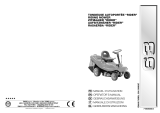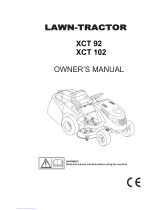1.2 SAFETY REGULATIONS
(read carefully before using the machine)
A) TRAINING
1) Read the instructions carefully. Be familiar
with the controls and the proper use of the
equipment.
2) Never allow children or people unfamiliar
with these instructions to use the machine.
Local regulations can restrict the age of the
operator.
3) Never mow while people, especially child-
ren, or pets are nearby.
4) Bear in mind that the operator or user is
responsible for accidents or hazards occurring
to other people or their property.
5) Do not carry passengers.
6) All drivers should seek and obtain profes-
sional and practical training which should
emphasise:
– the need for care and concentration when
working with the machine;
– control of a machine sliding on a slope will
not be regained by the application of the
brake. The main reasons for loss of control
are:
– insufficient wheel grip;
– being driven too fast;
– inadequate braking;
– the type of machine is unsuitable for its
task;
– lack of awareness of the effect of ground
conditions, especially slopes;
B) PREPARATION
1) While mowing, always wear substantial
footwear and long trousers. Do not operate the
equipment when barefoot or wearing open
sandals.
2) Thoroughly inspect the area where the
equipment is to be used and remove all
objects that can be thrown by the machine.
3) DANGER! Petrol is highly flammable:
– store fuel in containers specifically designed
for this purpose;
– refuel outdoors only and do not smoke while
refuelling;
– add fuel before starting the engine. Never
remove the cap of the fuel tank or add petrol
while the engine is running or when the engine
is hot;
– if petrol is spilled, do not attempt to start the
engine but move the machine away from the
area of spillage and avoid creating any source
of ignition until the petrol vapours have dissi-
pated;
– replace all fuel tank and container caps
securely.
4) Replace faulty silencers.
5) Before use, always visually inspect to see
that the blade, blade bolts and cutter assembly
are not worn or damaged. Replace the worn or
damaged blade and bolts in sets to preserve
the balance.
C) OPERATION
1) Do not operate the engine in a confined
space where dangerous carbon monoxide
fumes can develop.
2) Mow only in daylight or good artificial light.
3) Before attempting to start the engine, disen-
gage the blade and shift into neutral.
4) Do not use on slopes of more than 10°
(17%).
5) Remember there is no such thing as a
“safe” slope. Travelling on grass slopes re-
quires particular care. To guard against over-
turning:
– do not stop or start suddenly when going up
or downhill;
– engage the clutch slowly and always keep
the machine in gear, especially when travelling
downhill;
– machine speeds should be kept low on
slopes and during tight turns;
– stay alert for humps, hollows and other hid-
den hazards;
– never mow across the face of the slope.
6) Stop the blade from rotating before crossing
surfaces other than grass.
7) Never operate the machine with defective
guards, or without safety protective devices in
place.
8) Do not change the engine governor settings
or overspeed the engine. Operating the engine
at excessive speed can increase the hazard of
personal injury.
9) Before leaving the operator’s position:
– disengage the blade and lower the cutting
deck;
– change into neutral and set the parking
brake;
– stop the engine and remove the key ( in
the electric start models):
10 Disengage the blade, stop the engine and
remove the ignition key ( in the electric start
models):
– before clearing blockages or unclogging
chutes;
– before cleaning, checking or working on the
machine;
– after striking a foreign object. Inspect the
machine for any damage and make repairs
➤
➤
EN 4 SAFETY





















